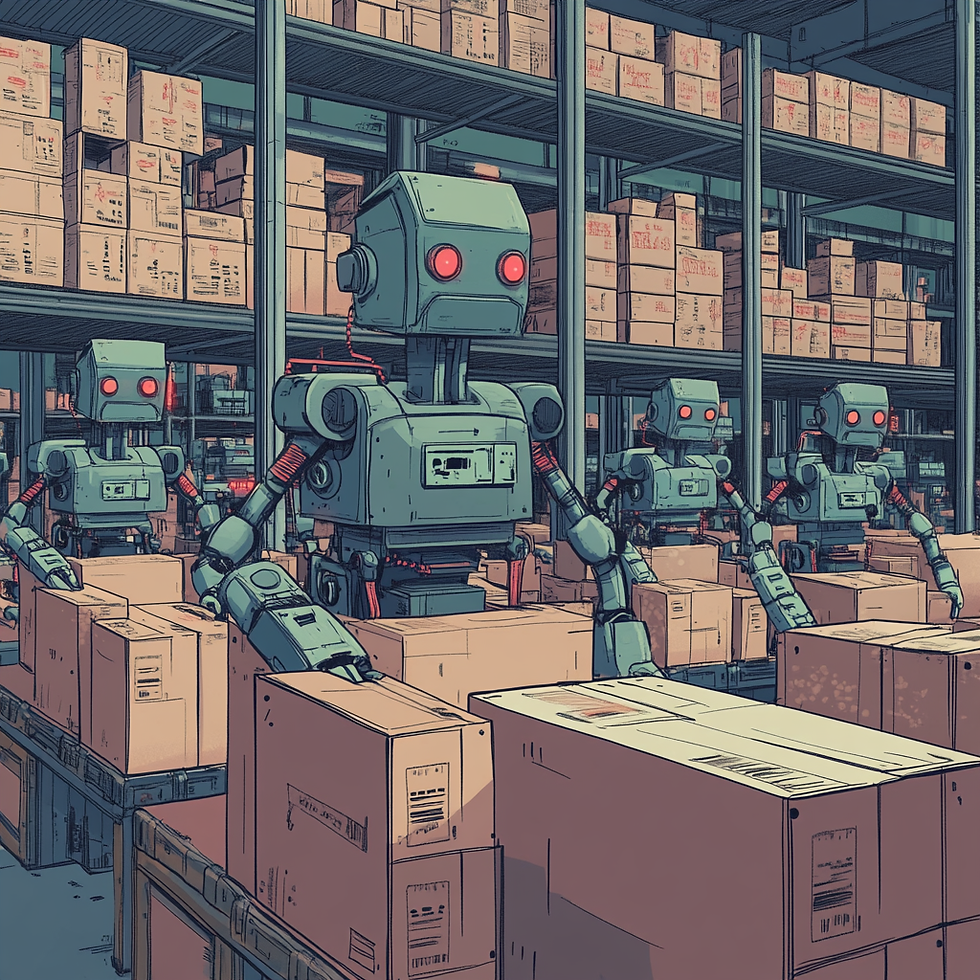Symbotic: The Robots Are Coming, and They’re Taking Over Warehouses First
- Brett Hall
- Dec 1, 2024
- 4 min read

Let’s talk about Symbotic, the robotics automation company quietly revolutionizing how warehouses function and setting the stage for a fully automated logistics industry. This isn’t just about faster package delivery or replacing forklifts with glorified Roombas—it’s about creating a supply chain ecosystem so efficient that it may soon be unrecognizable. With a blend of cutting-edge AI, vision systems, and smart software, Symbotic is setting itself up to become the backbone of modern warehousing.
Sure, automation comes with fears of mass unemployment (those dystopian headlines write themselves), but let’s set aside our worries about robot overlords for a second. Symbotic’s stock has had its ups and downs, but from where I’m standing, the long-term investment case is as solid as the steel used to build its robots.
The Rise, Fall, and Rebirth of Symbotic’s Stock
Symbotic’s public life began during the 2022 SPAC craze. Like many companies that rode the special purpose acquisition vehicle wave, its stock soared, peaking at $64. Then reality hit. It now trades around $27, having faced the usual post-SPAC skepticism and a recent sell-off tied to what I’d call a nothingburger accounting issue. Let’s break that down.
The company delayed its annual filing due to minor restatements of quarterly financials. The issue? They accounted for expenses too early in the year. If you’re picturing Enron-style shenanigans, don’t. Symbotic’s management clarified that the adjustments won’t change their full-year numbers by a single dime. This isn’t fraud; it’s bookkeeping that needed a tweak. Yet the market panicked, sending the stock down nearly 37%.
For savvy investors, this was a gift. Symbotic’s projected annual growth rate is nearly 70% over the next four years, driven by booming demand for automation. The PEG (price-to-earnings growth) ratio is a lean 1.36—impressive given the lofty valuations in today’s market. In simpler terms, this company offers growth at a reasonable price, especially for a robotics leader.
Why Contract Manufacturing Is Symbotic’s Secret Weapon
Symbotic doesn’t make its robots in-house. Instead, it outsources production to contract manufacturers. While this might sound like a cop-out, it’s actually a brilliant strategy. Contract manufacturing keeps the company asset-light, allowing it to scale rapidly without the headache of managing factories. Think of it as the “Uber of robotics”: Symbotic owns the intellectual property and designs but lets someone else handle the grunt work.
The downside? Contract manufacturing can skew cash flow. For example, last quarter, Symbotic reported negative cash flow due to prepaying suppliers. But dig deeper, and you’ll see the company is far from struggling. With $727 million in cash reserves and $382 million in accounts receivable, its balance sheet is rock solid.
More importantly, outsourcing gives Symbotic the flexibility to weather economic downturns. If demand slows, they simply scale back orders. Compare that to companies that own their factories and face massive overhead costs during slow periods—Symbotic’s approach is a masterclass in resilience.
The SoftBank Partnership: Warehouses-as-a-Service (WaaS)
Symbotic’s partnership with SoftBank is nothing short of a game-changer. Together, they’re launching a $125 million warehouse-as-a-service (WaaS) facility near Atlanta, Georgia. The idea is simple yet revolutionary: think Amazon Fulfillment Centers, but open to everyone.
SoftBank takes on 65% of the risk, while Symbotic gets 35% of the upside—and, more importantly, sells the robots powering the operation. If this pilot succeeds, it could spawn a new revenue stream for Symbotic while boosting demand for its robots across the industry. Imagine businesses outsourcing warehousing the way they currently outsource cloud computing.
And here’s the kicker: SoftBank has agreed to purchase $7.5 billion worth of Symbotic’s robots over time. That’s not just a handshake deal—it’s a multi-billion-dollar vote of confidence in Symbotic’s technology and its ability to dominate the logistics space.
Robots With Vision: The Next Frontier in Automation
Symbotic isn’t resting on its laurels. The company is doubling down on innovation, integrating vision-based AI into its robots. This technology allows robots to “see” their environment, handle unexpected situations (spills, broken products, etc.), and work more efficiently alongside humans.
This isn’t just an upgrade—it’s a game-changer. Vision-based AI opens the door to a software revenue stream, as Symbotic plans to license its AI platform to customers. With 50% profit margins on software, this could significantly boost the company’s overall profitability.
Symbotic recently acquired eFreeMove, a company specializing in lidar technology to enhance robot safety and navigation. The goal? Make robots smarter, safer, and more adaptable. This acquisition strengthens Symbotic’s moat, making it harder for competitors to catch up.
The Valuation: Is Symbotic a Steal at $27?
Let’s talk numbers. Using conservative assumptions, Symbotic’s fair value could range between $71 and $98 per share by 2027. This projection accounts for a slight slowdown in growth and doesn’t even fully price in the potential upside from software sales or the WaaS model.
If growth holds steady at 69%—which is plausible given the booming demand for automation—the valuation jumps to $125 per share by 2028. That’s nearly a 5x return from current levels.
Even with all the optimism baked into these numbers, there’s plenty of room for error. Symbotic is well-capitalized, has strong partnerships, and operates in a market that’s only going to grow. Robotics and AI aren’t fads—they’re the future.
The Big Picture: Why Symbotic Could Be Recession-Resistant
Here’s the kicker: even in a potential recession, Symbotic looks poised to thrive. Companies will still need to cut costs, and automation is the obvious solution. Symbotic’s robots can reduce labor expenses, improve efficiency, and minimize errors—all critical in an economic downturn.
Plus, the company’s international expansion plans, particularly in South America, could unlock enormous new markets. With partnerships in place and its WaaS model gaining traction, Symbotic is well-positioned to capture global demand for robotics.
A Bet on the Future
Investing in Symbotic isn’t just a play on warehouse robotics; it’s a bet on the evolution of supply chains and global logistics. With a strong balance sheet, innovative technology, and high-profile partnerships, this company has all the ingredients to become a dominant force in automation.
Yes, the risks are real—growth could stall, competition could heat up, and valuation multiples could compress. But for investors willing to stomach some volatility, the potential rewards far outweigh the risks.
Ticker: SYM. Long-term price target: $71-$98. Am I bullish? Absolutely.









Comments